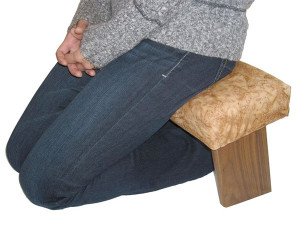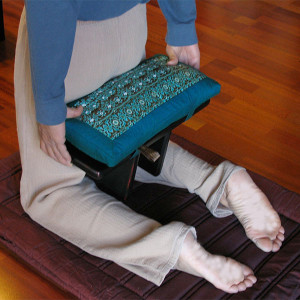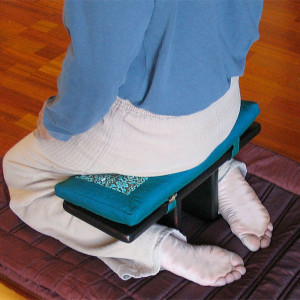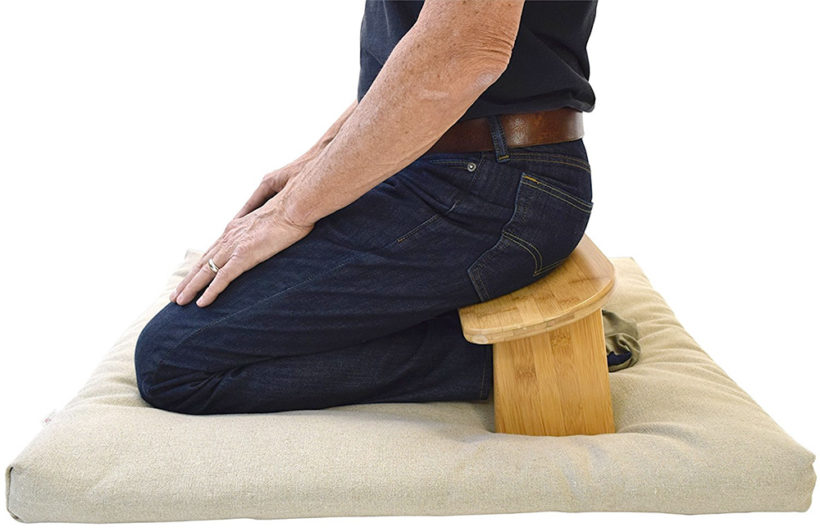How to Use a Meditation Bench
When you first decide to use a bench as a part of your daily meditation practice, it can be tricky to figure out what is the best way to use it. You want to make sure to use a bench properly to ensure proper alignment of the back and also to make sure your legs and ankles are comfortable.
The purpose of a meditation bench is to assist you when meditating in a kneeling position. Sitting your bottom on the bench helps align your spine correctly while absorbing the weight of your upper body. It also protects your ankles, which will rest without pressure underneath the bench.
When you are sitting on your bench correctly, you should feel completely comfortable, especially in the legs and knees. As a result, you should be able to kneel and meditate for longer without any discomfort or pain.
We will cover how to use multiple styles of meditation benches.
Kneeling with a Meditation Bench
First, you will want to get into a kneeling position on the floor. I recommend kneeling either on a rug, a folded blanket, a zabuton cushion, or a pillow to protect your legs and knees from the floor. (If because of physical limitations you cannot kneel, you should consider using a chair to meditate.)
 Once you are kneeling, lift your bottom off of your ankles and slide the bench under your sit bone. You may need to adjust the bench forward or backward, or the tilt of the bench until you can find a comfortable angle to sit.
Once you are kneeling, lift your bottom off of your ankles and slide the bench under your sit bone. You may need to adjust the bench forward or backward, or the tilt of the bench until you can find a comfortable angle to sit.
Your weight should be supported by the bench, your ankles should be flat against the floor underneath the bench, between the two bench legs. If your ankles are not flexible enough to lay flat on the floor, use a blanket or cushion to support your legs and let your feet hang over the edge for more comfort. Another option is to roll a towel and place it under the ankles.
 Make sure to adjust the bench to get the perfect height and angle for sitting. If you use a bench that is too high, it will put too much weight on your knees, which will quickly become uncomfortable. If the bench is too low, it may put pressure on your ankles. If you bench has curved feet, you should be able to adjust the angle of the bench until your body is properly supported. You can also use blankets to increase or decrease the height of the bench.
Make sure to adjust the bench to get the perfect height and angle for sitting. If you use a bench that is too high, it will put too much weight on your knees, which will quickly become uncomfortable. If the bench is too low, it may put pressure on your ankles. If you bench has curved feet, you should be able to adjust the angle of the bench until your body is properly supported. You can also use blankets to increase or decrease the height of the bench.
You may need to experiment until you get the right height and angle. You should make sure there is no discomfort in the legs and ankles, and your spine should be straight.
Here is a video you can watch for a physical demonstration of how to use a meditation bench:
How to Use a Pi Meditation Bench
A Pi style meditation bench features a leg or two legs toward the center of the bench instead of on the outside of the bench. These are perfect for people who are taller or feel confined by a regular style meditation bench.
Using these benches is very similar to a regular bench with a few adjustments. This biggest difference is that your legs will rest on the outside of the bench, allowing for more freedom of movement and making it easier to get in and out of the kneeling position.

To sit on the bench, there are two options: first is to start in a kneeling position and then raise your bottom up and slide the bench between your legs and under you. The other is to slide your body onto the bench with your leg moving underneath it (this is demonstrated at 4:20 in the video below).
Just like with a regular bench, you may want to consider using a cushion or a mat to provide a softer surface for your legs and ankles. Though this bench tends to be more comfortable for the legs, you may need to make adjustments for tight ankles. A rolled towel works well to support tight ankles without affecting the position of the bench.

Once you are sitting on the bench, adjust it to make sure your upper body is properly supported and there is no pressure on your knees or ankles. The design makes it easier to adjust, and you can tilt the bench as needed to get the perfect angle for you.
Your back should be straight, shoulders relaxed, and hands resting on your thighs, palms open to the sky. If needed, adjust the tilt of the bench to support your back. Just make sure not to tilt too much of your weight into your knees.
Here is a video describing the different type of pi benches, with a demonstration of how to sit on them:
The Pi bench featured in this video is available for purchase from Amazon. There is also a folding travel version available.
Looking to add a meditation bench to your practice? Check out our recommendations for home meditation benches and portable benches for meditating.
